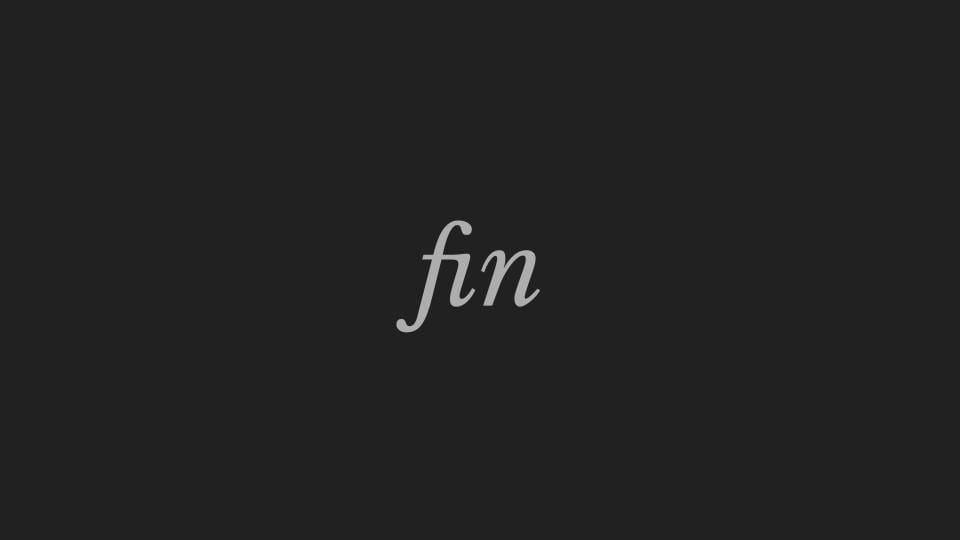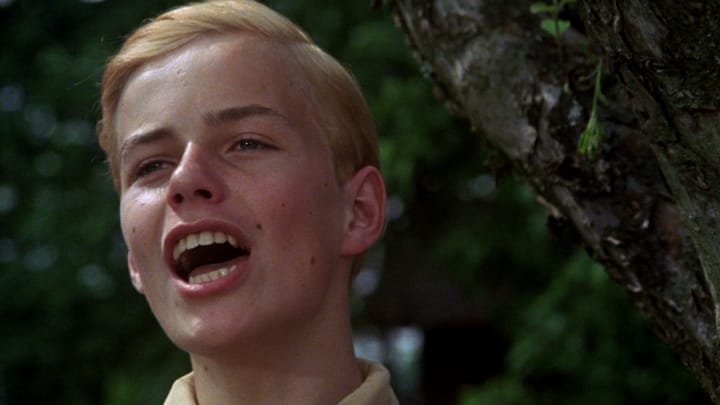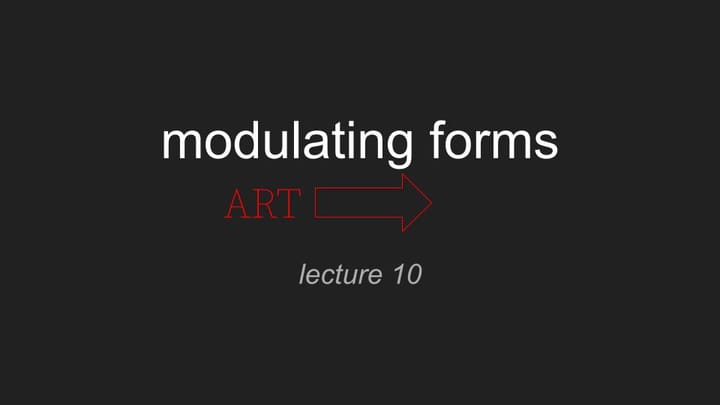moving image: theory | context: lecture 7
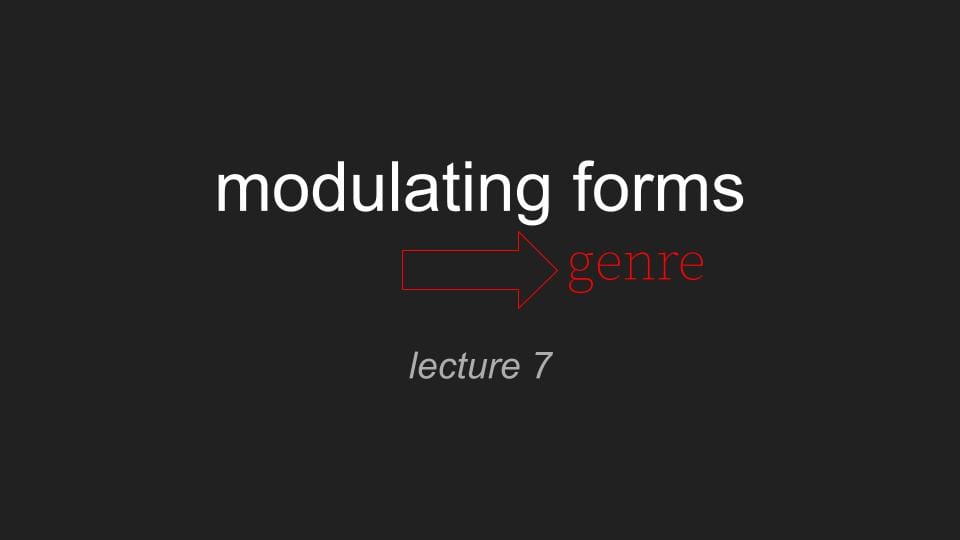
We started our story of modulation, how a mode of form becomes what it is, with the example of the Lumière brothers’ Le repas de bébé. Part, perhaps not the most important part of the programme of cinema, motion writing, shown on 28 December 1895 at the Salon Indien, Grand Café,14 Boulevard des Capucines, Paris.
The programme also included the much more famous because much more dynamic L’Arrivée d’un train en gare de la Ciotat. The Arrival of a Train at La Ciotat Station. The one where audiences ducked or screamed or got up to run away as the engine increased in size in the shot until it looked like it would bust through the screen.
So it is said. Because this, no matter how true, is a myth. A myth of the birth of cinema. Motion writing.
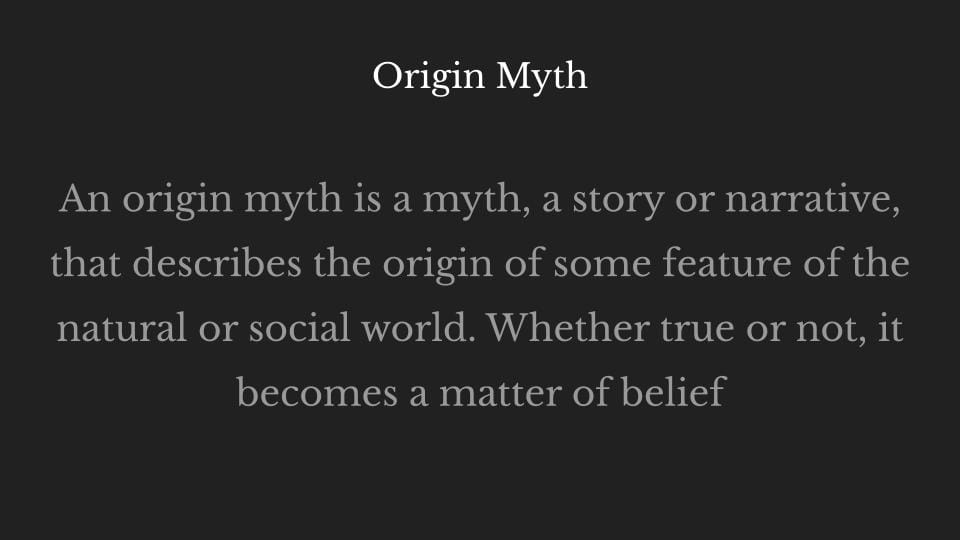
Motion writing that begat motion pictures that begat, after many begattings, motion graphics.
The audience ducked or screamed or got up to run away as the engine increased in the shot until it looked like it was going to hurtle through the screen...
These two words should make us pause: shot and audience, because the audience weren’t there to hear the train, or the dramatic simulation of its response pounded out on a piano or pianola, but for the experience...
Of the shot. The mystery of the shot.
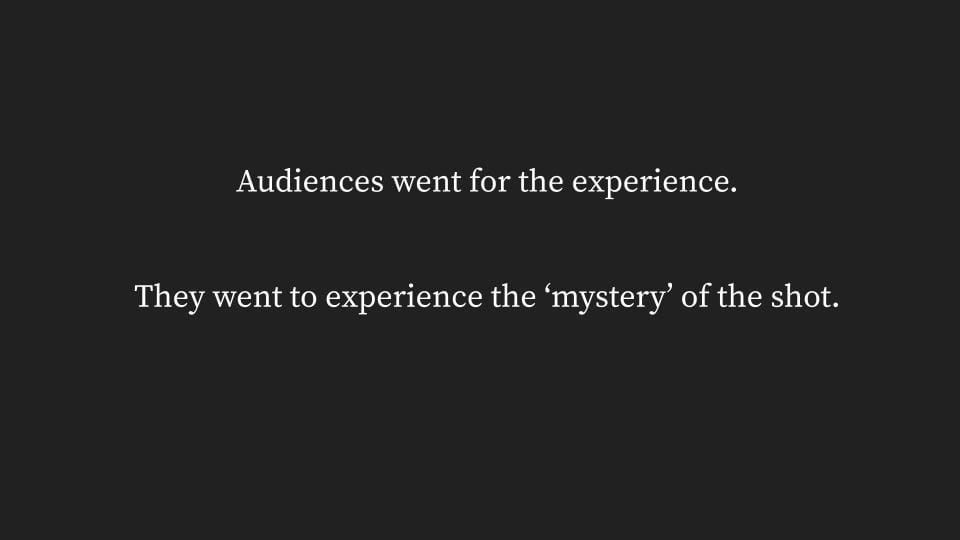
Mark Cousins in his book The Story of Film calls our attention to the shot, because…
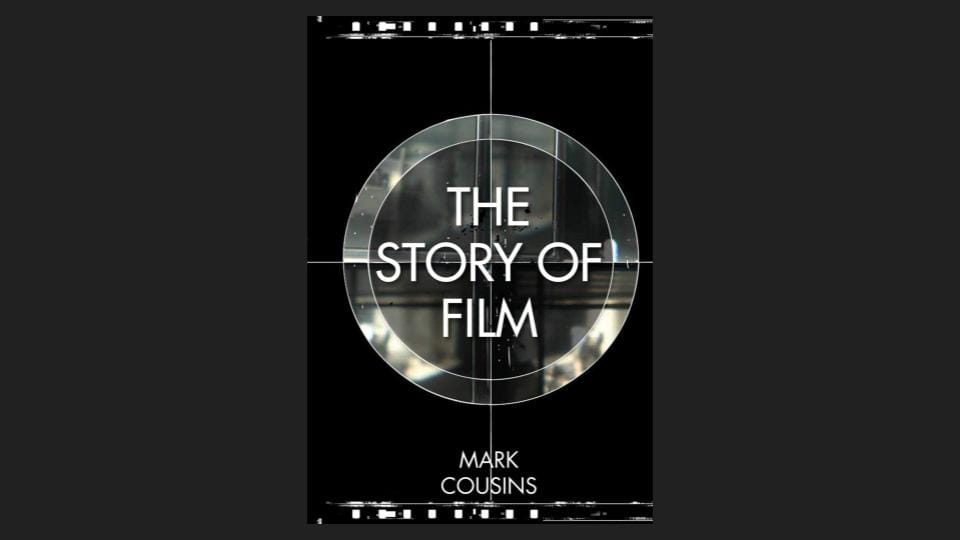
… we now take for granted the registration of a moving image, on the one side, onto a piece of Eastman celluloid, with sprocket holes down the sides, that the cinematograph succeeded in advancing, and exposing to light, 16 times per second, by a mechanism borrowed from a sewing-machine; and, on the other, take for granted the registration of the moving image on our visual apparatus, which occludes, through the phenomenon of persistence of vision, the changing frames of which the movement is composed, and in which the motion writing actually consists. Or consisted.
It no longer so consists. Has been naturalised as a phenomenon. And we have noted in the past we have retained almost all the ways of thinking about it from its earliest origins in our own appreciation and application of digitally produced imagery and computer-animated graphics, CGI. Where the sparkle of the tiny lights called pixels constitutes the movement.
A movement that, no matter how fluidly they do so, is still occurring.
What is this mystery, of the shot, with its one side in the organism of the animal and its other in the technical apparatus? It is the movement-image, named after Bergson by Deleuze.
For Bergson, you remember, the image comes inbetween.
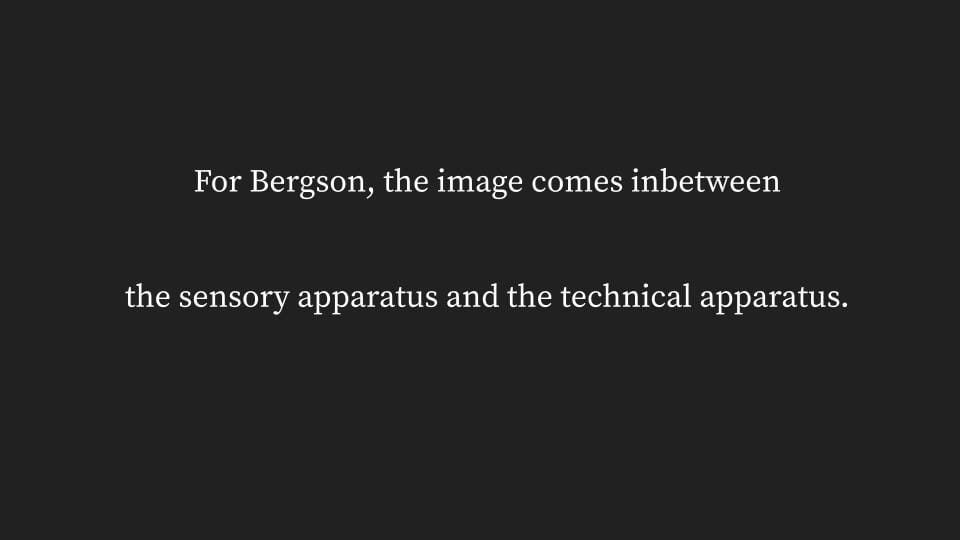
It doesn’t have the ‘reality’ of the object, the objective reality, that science studies ... and so tells us that we don’t really see it because the object is composed of so many tinier objects, which are, like the germs that can kill us, invisible, that are, in turn, the effects of quantities of energy called quanta. Neither is the moving image, the movement-image the illusion or hallucination of what we see, so that its affects on us are subjective. So become the objects for study of psychology.
Nor does it, for being the mental image we are most used to thinking of as an image, that art reproduces, lack reality. The image art either represents or expresses, the arts of CGI and 3D motion graphics included. So that we tend both to doubt the reality of what we see on screens and to believe in the reality of what is represented there: to doubt the shot and believe in the shoot, in what is shot. To believe in, to ‘go with’ and let ourselves be affected by the reality on a screen, on any screen, putting to one side the reality of it, this is to do with the mystery of the shot.
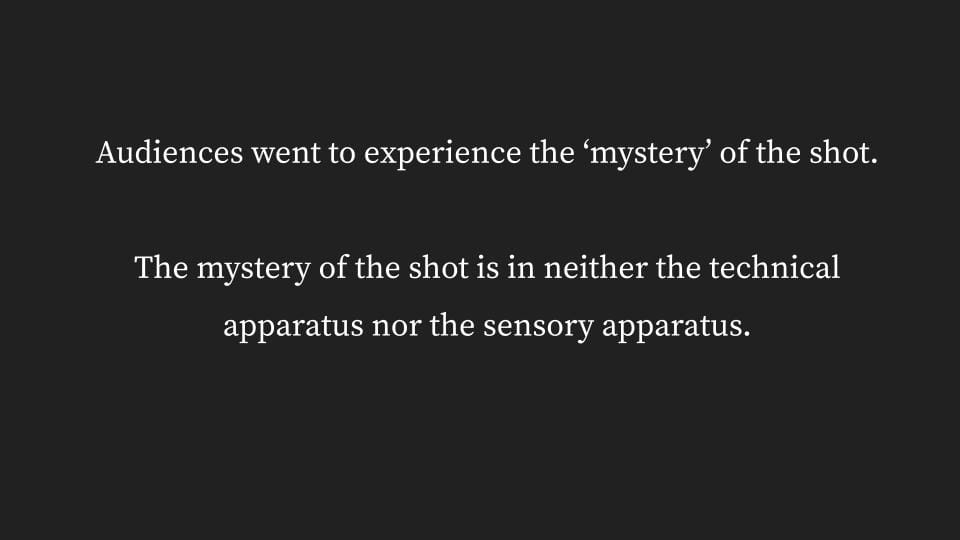
And it is neither more nor less a liability to be fooled, a gullibility or credulousness, than thinking the objects about us are real, real for science, if you think about it.
The mystery of the moving image, of the movement-image, is not in either the apparatus of capture or of reception of the shot.
To appreciate it we have to go back to the story of origins. Of the cinema. Of film. And ask audiences,
So, what’s new?
What’s the attraction?
Like those old advertising hoardings used to announce: The coming attraction... This is why we spent so long with Le repas in the last lecture.
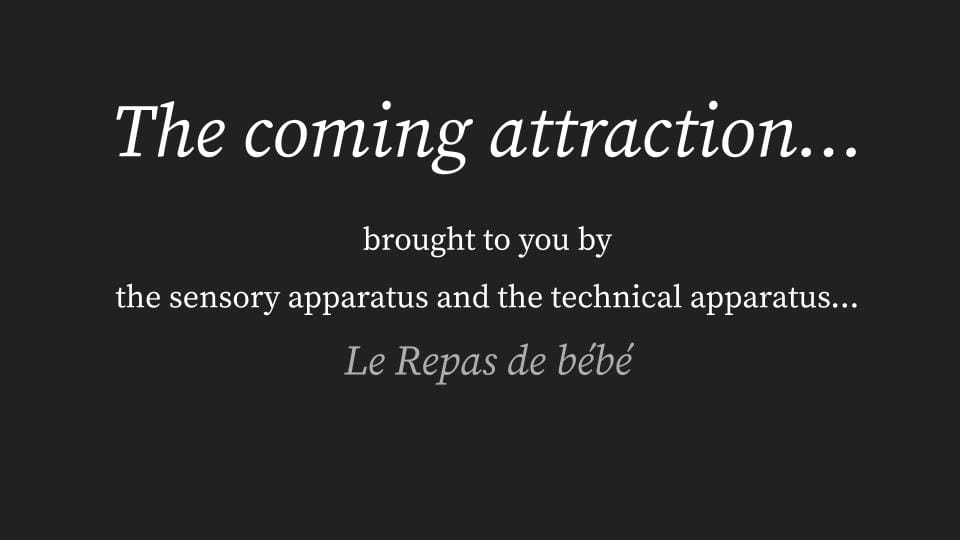
To find out what was revealed in the end. What really blew audiences away.
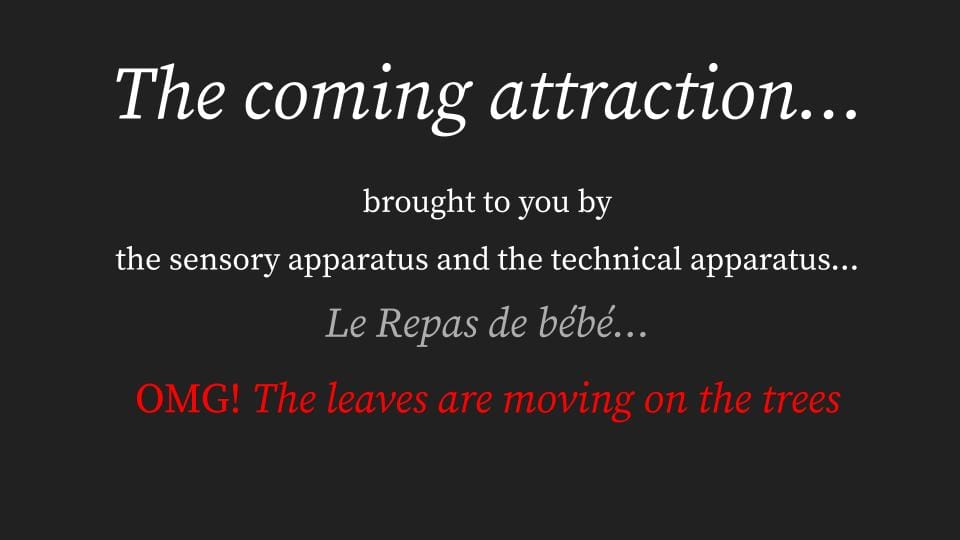
The leaves were moving on the trees.
They’d seen this before. They’d seen leaves moving on trees before. What’s the big deal? The fact that they had seen them, before, and were seeing them, again.
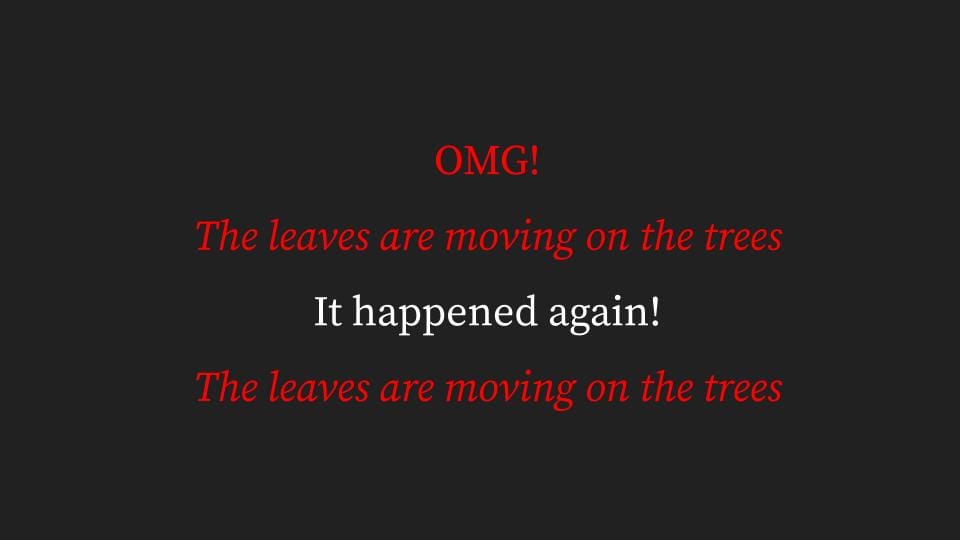
Why was the leaves moving on the trees the mystery?
Why was not anything else received by the audience as having happened before and happening again?
Why was it this, not the attraction listed on the bill as the main one, Andrée at feeding time?
That had happened before. Was captured by the apparatus and shown by the Lumière brothers, with Marguerite and baby, as being the main attraction.
Was it that an audience would have been familiar with feeding baby as an event not worth the money of paying to see?
Or was it, as some critics have said, that this kind of action could also be shown on stage, in a theatre, and repeated, night after night, with willing actors and rising child star?
Was it for this reason the mystery of the shot captured by the cinematograph and depicted on the screen was not Le repas de bébé as advertised but the leaves moving on the trees...?
Or, C. For another reason. Or, D. All of the above.
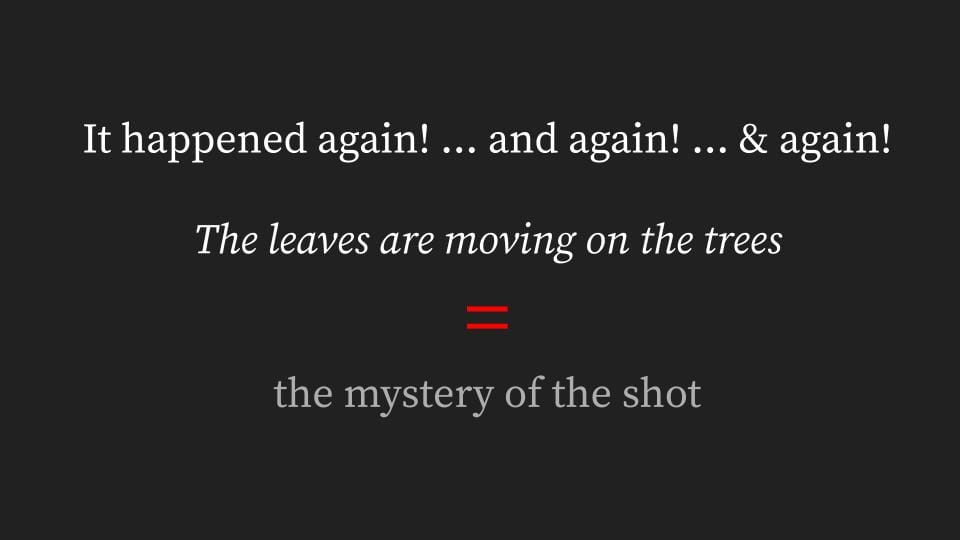
We should think about what is repeated in the moving image.
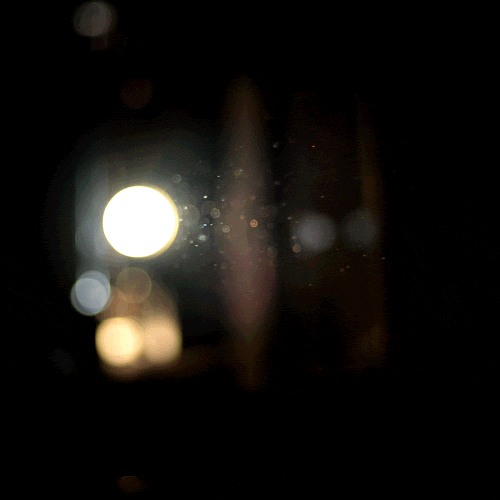
Because it’s not action.
The action announced by Lights! Camera! and... Action! is narrative, a different kind of action. It’s action as voluntary movement, or the actions of a worker or an actor, those elicited from them, either by incentive, by force or by their own initiative. Those of art, science or labour.
And that mythic action of the locomotive hurtling towards the cowering audience.
The mystery of the shot is that it shows what cannot be achieved by any of these means. The mystery of the shot is that it can only be achieved by technical or mechanical reproduction.
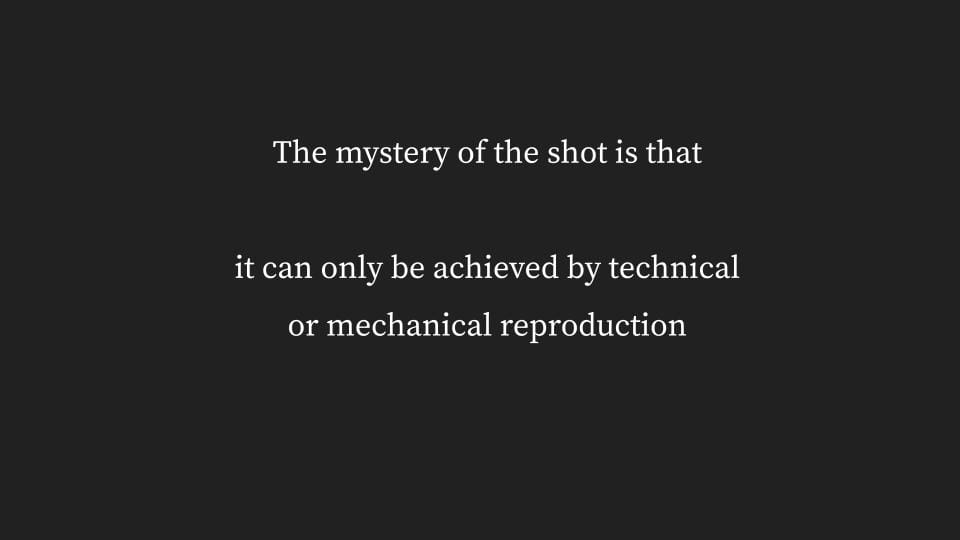
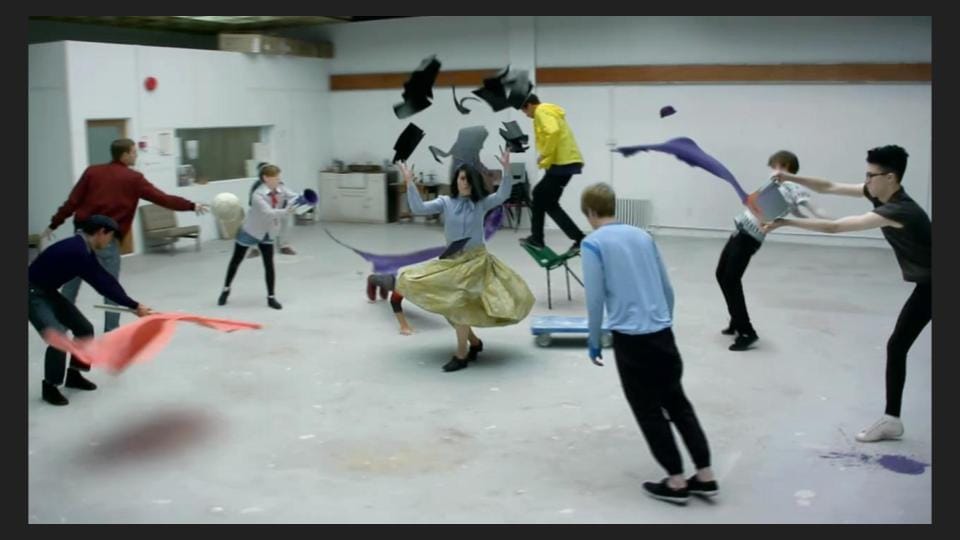
Time frozen, has been said of the photograph.
So the moving image or movement-image is time un-frozen?
Like the moment of slow suspension when we come to realise we are walking into thin air and about to plummet off a cliff?

We could call it here the accident of time... Or the agency of time itself. Because the agency of time itself is to pass.
Repeated, it’s a mystery.
That’s the shot. More like a slice of time, or a time inner to the shot.
That’s the novelty. That’s what’s new about the moving image sequence that is covered over by the origin myth, with the engine about to burst through the screen, that has the audience running for the exits. No, we want to know why they stayed, and came back.
The novelty comes from this mysterious ability, the technical ability of art in the age of mechanical reproduction...
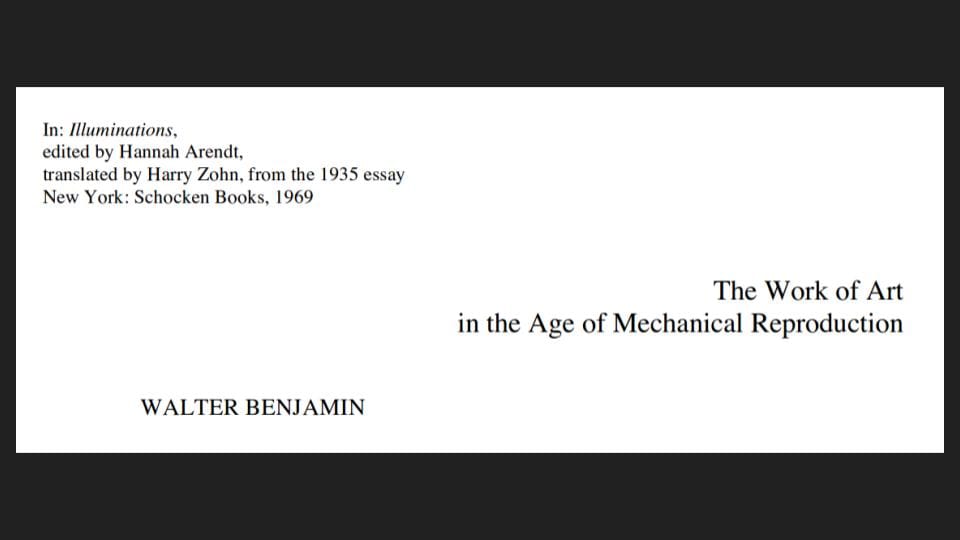
...to replay the unrepeatable because stochastic, chaotic and random.
...to replay the unrepeatable because it is, as Deleuze and Guattari say in their book, What is Philosophy?, a slice of chaos.
The novelty is actually the end of novelty. It’s the end because what is new is no longer unique. It no longer belongs to chaos. Even as a process, a happening, an event, it is repeatable.
...
Walter Benjamin is misunderstood in his essay of 1935 if it is thought he is referring to what is particular to an artwork, or to what is unique and singular in general. The title of this essay is not “The Work of Art in the Age of Its Reproduction.”
The reproduction he is referring to is not so much to do with the reproduction of an original, like an artwork, as to do with the overcoming of any sort of origin or process or event of origination, as happening in an original and unrepeatable time, by the fact that time itself can be repeated, in the here and now, of the shot. That is, the moving image, or movement-image.
The word he uses to cover a sense of loss, without himself giving way to any sense of loss, is aura. And by this word we are to understand not what is intrinsic to the object, or the kind of movement that is intrinsic to it, but what is, and that kind of movement that is, incidental to it. Contingent to it.
This is the action or agency of time: it’s the wear and tear, the traces of history, which mark the passage of time. They mark the original as it ages as much as the maker’s mark.
Here, in the age of mechanical reproduction, the object and its movement,, whether it’s art or not, as much as the actor and theirs’, that Benjamin also mentions, is freed from time.
The aura is lost, without a sense of its loss: in fact this sense is the coming attraction.
...but we must mean it is uncoupled, made discontinuous with; time is no longer feeling itself. By freed from time we must think of what were previously points in time, which now can be repeated. And the proof that they can be is not found in the points themselves but in their whole surroundings which are no longer contingent on them and on which they are no longer contingent.
By freed from time ... if we take that magical word, aura, Benjamin uses ... we must think of a freedom that is from all of time, from the prison of the present as well as the dusty musty display-cases of the museum, from the past as well as freedom from the future: but don’t we want the future and its promise?
The issue here is do we want it if progress means the inevitable progress to climate death? Do we want it in the form of modelling from present trends? Do we want it by algorithm? Do we want it in the form of the moulding and modulation which is the form of control in Deleuze’s “Postscript on the Societies of Control”?
...
So by freed from time we must really be saying freed from the automatisms of the historical narrative, from historical determinism, and the time of historicity, which, for Bergson, is not time at all.
Bergson’s answer comes in part from a very famous book, a series of books, with the title, In Search of Lost Time. À la recherche du temps perdu.
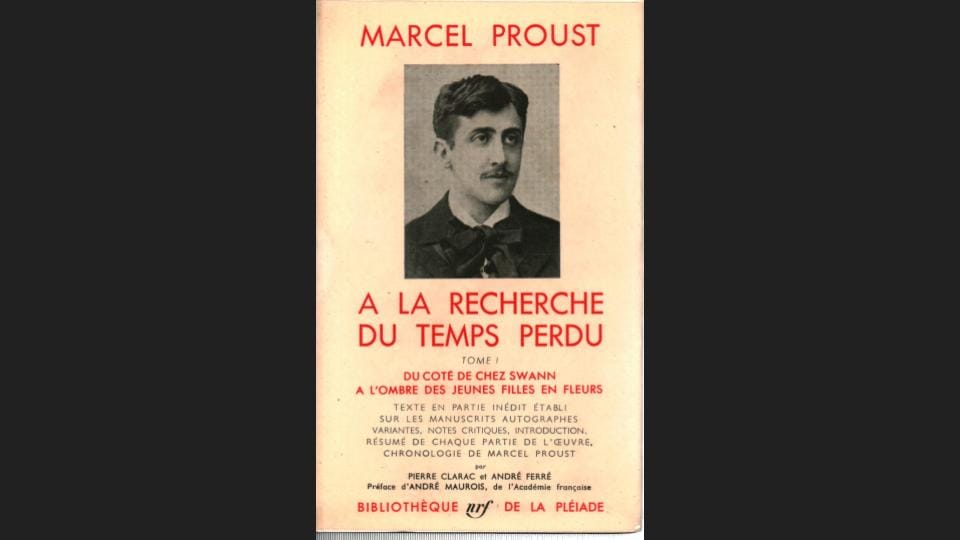
We recognise in the French title the word recherche which is more like the English, research. Because the books by Marcel Proust use the form of the novel to conduct research, what we might call art research. Into memory.
And that is why the title is sometimes translated as Remembrance of Things Past.
What is thought in the form of the novel? Proust discovers through the experience of his characters involuntary memory. It comes along, and, like a train engine, bursts through the screen of the ordinary and voluntary and the historically determined.
A smell, a taste, and from it a whole world opens up that the character thought lost. And it would have been lost, as lost in the present as it was in the past, and as lost for the future, as either the past or the present, except for an involuntary spike of attention, at which the character pays attention to what they are paying attention to: and all seven or so books are this act of contemplation.
They constitute what we have noticed before: the furthest loop of memory, of a memory that happens to us, happens upon us. Like an accident. Where we had been comfortably sipping tea, or coffee, and had taken a small sort of cake or biscuit offered to us: and in its smell, its taste, perhaps, even, just in the sight of it, now we are sensing what we are sensing, we are taken over by... by what? Can we say it’s the past? as in remembrance of the past?
No. We can only say it’s the lost. Perdu.
Just like the loss Walter Benjamin attributes to aura, without a sense of loss. Without a sense of loss because of this involuntary repeat. Because of its mechanical or technical reproduction.
And in what aspect is it involuntary? Research into the aura might proceed the same way: not through the technical reproduction of what is intrinsic to the artwork, but through the technical reproduction of what is purely accidental.

The aura is lost in the same way time is lost... of course, one of the volumes in Proust’s À la recherche will be Time regained...
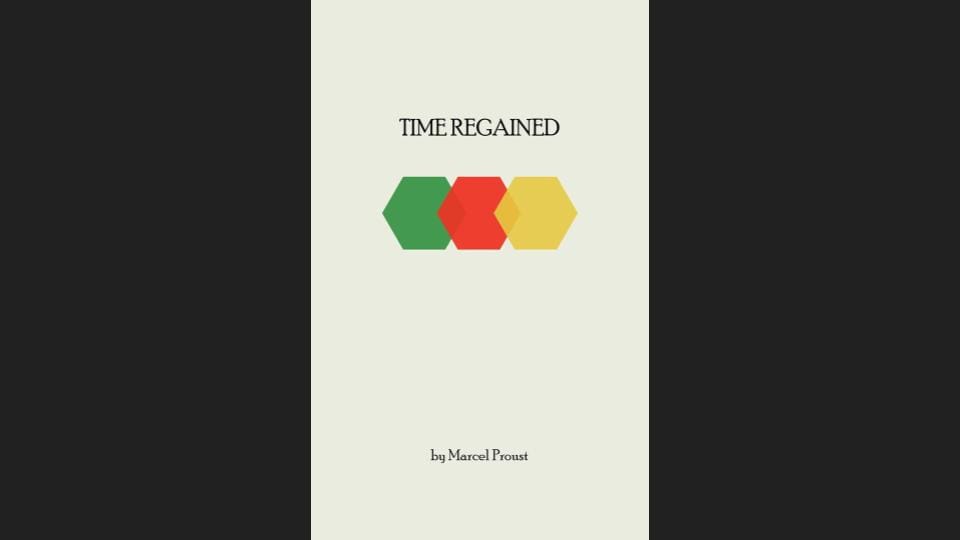
And what is this aura? Benjamin states it... I’ve found it so interesting going back to this essay, because it’s clear that its problem is the moving sound image and both the cinematic and the televisual, meaning, as we know, distance seeing:
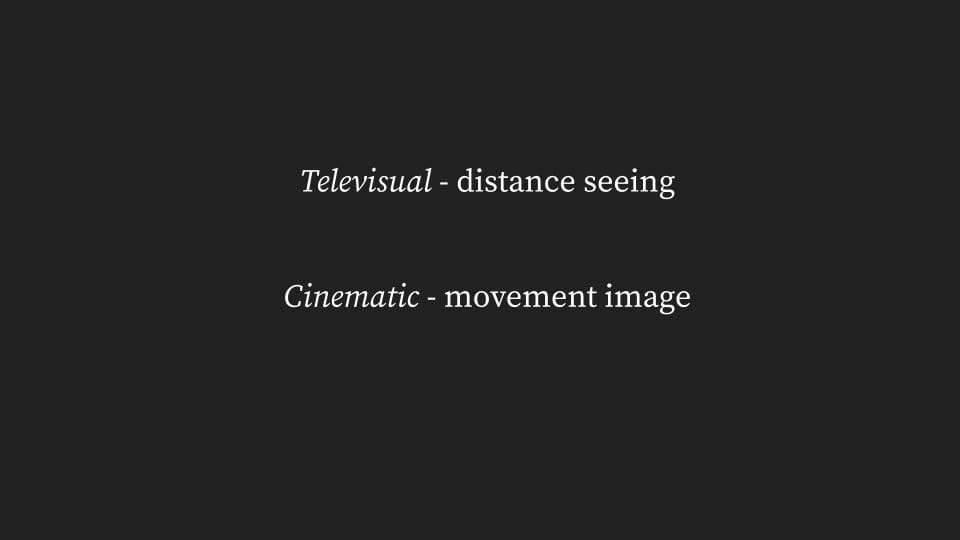
…on the side of the televisual there is his discussion of the convenience of having images piped into your home and the loss of presence that it implies, because the objects shown are not there, the person is not there... And recall that he says photography retains something of its cult through memorialising those we have lost, like Roland Barthes’s mother... The sense of cinema, of motion writing and the movement-image, is usually left out of discussions of Benjamin’s strange, even he calls it unusual, invention, the aura. But I think it explains as much the revolutionary potential of the moving image according to Benjamin, as his positive account... that is, the revolutionary potential of the moving image does not fully account for it... of what seems like the loss of magic from the world. And he almost presents it that way.
Without the aura of a thing, a living presence, the image reproduced by technical and mechanical means remains... And it is in a sense all that remains. In a world without origins or novelty, because novelty’s on repeat.
All we have left to do is perfect the images...
...but we can give a cinematic account of this word, aura: And it’s what I would also call an expressive or modulatory explanation of it: Because the image itself is what is not lost: It originates in its showing, which, for us, is also in its thinking; that is, as it is thought.
So aura and moving image are one thing: it is simply a question of finding again the aura in the image. And this is what I think we are doing with ... a bunch of leaves shown moving on the trees ... This is, after all, the novelty.
... or smoke as it billows from a chimney or the dust from the smashing of a wall...
This clip too was on the programme in the Salon Indien at the Grand Café.
And, as we’ve said, from these the first cinematic genre of the ‘wave film’ ... capturing nature in the act... As the German film theorist Siegfried Kracauer put it, and this Jordan Schonig has as an epigraph to his excellent article from which I am working, and from which I am departing.
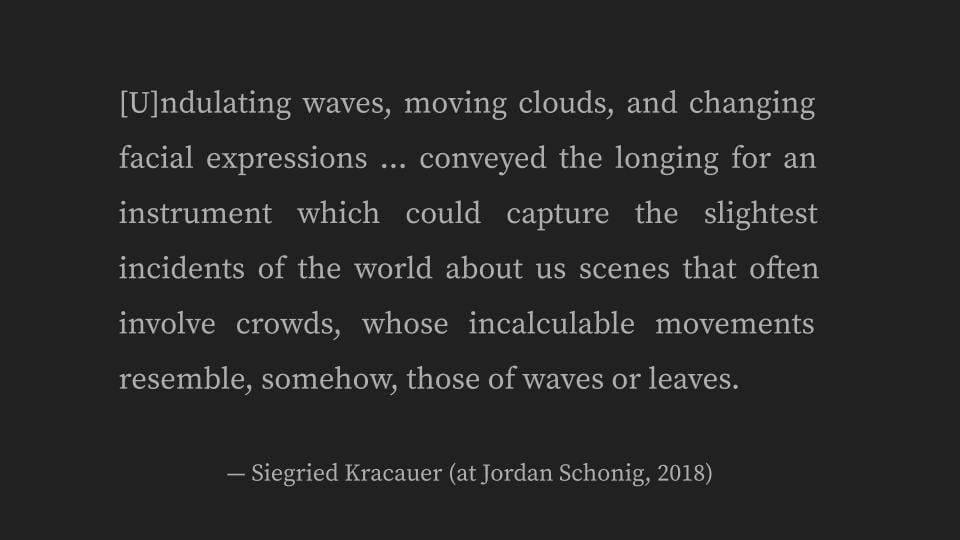
“Undulating waves, moving clouds, and changing facial expressions ... conveyed the longing for an instrument which could capture the slightest incidents of the world about us—scenes that often involve crowds, whose incalculable movements resemble, somehow, those of waves or leaves.”
...
We will meet the Jordan Schonig article in the lecture on VFX.
In these effects of the moving image, I am saying, contemporary audiences found a truth, the truth of the moving image. Kracauer is saying they desired it. Like the aura for Benjamin, the truth of the moving image is a temporal one: it has to do with time. And, for both aura and movement-image, it has to do with presence, with being in the presence of real time.
No other way could those movements be fabricated. No way were they made, but they were captured: waves or leaves.
The relevance for VFX will be clear, when we get to it.
...but then isn’t this a very thin sense of time? History compressed into the play of images on a screen?
Where is the depth? It seems to have gone with the loss of the aura... And this is the finding of another theorist, Jean Baudrillard.
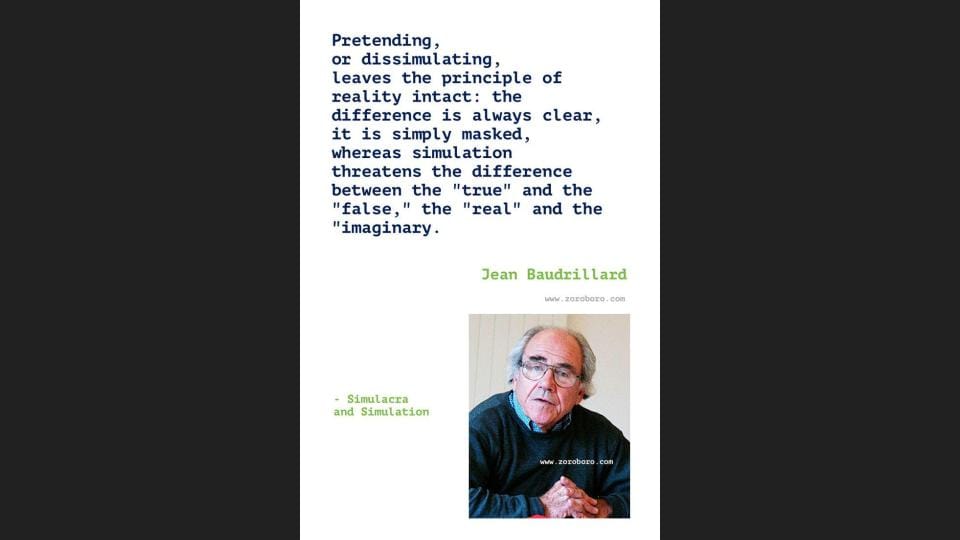
Jean Baudrillard by thinking through the image as a commodity form, as the commodity form belonging to capitalism, leads the way for Elon Musk’s belief that we inhabit a simulation, a computer simulation. And also, the Matrix.
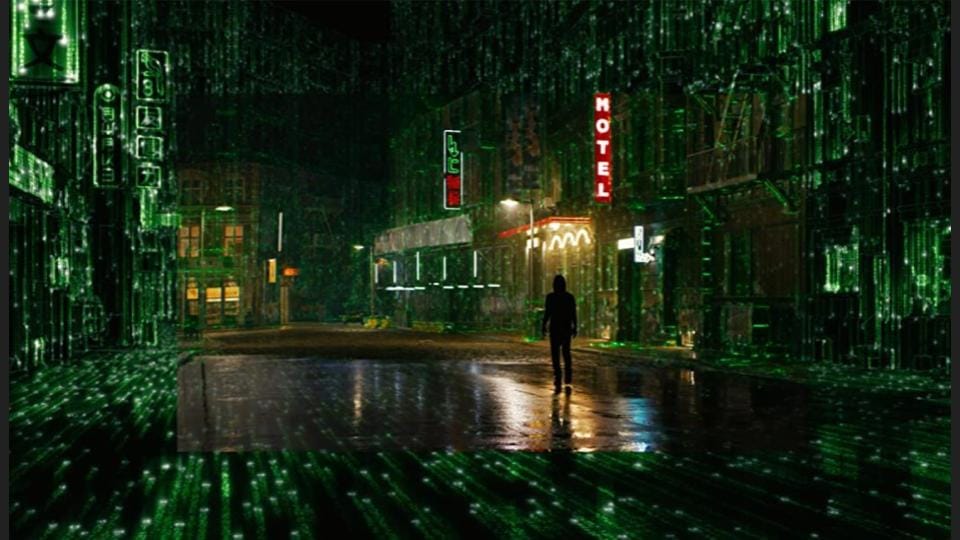
Although the Matrix’s world looks more like the world in the age of mechanical reproduction: it doesn’t have the thin-ness of a fleeting image, either in the simulation or in the world of Zion, where the struggle with the machines goes on; possibly because it’s difficult to show how thin an image the moving image is in a film which is itself one.
...but we are talking about the time being thin, the presence from which the image originates as being thin, which is where it is being shown, on a screen, or being thought: doesn’t it have the evanescence, the flimsiness and fleetingness of thought? That is, of an aura? That flickers once, and when we grab it, is like smoke? So we have to sort of sneak up on thoughts and
ideas.
In this world their movement is like clouds, smoke, leaves moving, difficult if not impossible to capture ... without the right bait. And they can run away with you just as much as they run away from you. While in the next room, David Lynch’s beautiful idea, they are whole and complete.
Is it true that the time of the moving image, of cinema, that cinematic and screentime is thin? Isn’t it only so to the degree we are habituated to it?
Doesn’t it thicken up when it recalls for us other scenes, from memory; and where it breaks out from what we recognise, from what is familiar and what we are comfortable with, doesn’t it sometimes overwhelm us? We find ourselves with complex emotions we can’t immediately process: we find ourselves with chaotic impressions, as if we, not those on the screen, in screentime, were the clouds, the waves, the leaves...?
...
It’s almost like the moving image thickens the less sense it makes, the more chaotic it becomes.
What we see in the leaves, the waves, the clouds and, yes, shadows, are that these patches of a chaotic reality gain from the moving image in which they occur, in which they almost have to, since we insist that if we are to reproduce reality in moving images, in animation particularly, the hair must move in the breeze, not sit in a clump on the head, the rain must not assume the inertness of geometry, but splash randomly; we insist that the essential is in these details, which are either produced, in the case of animated film, or reproduced, in cases, like we are discussing here, of early film: our desire to produce images moving randomly matches audiences’ desire, either then or now, to see reproduced images moving with a spectacular randomness, by chance: chaos gains a value from the moving image.
The valorisation of chaotic processes, chance and incidental happenings on screen, is not indexical. It’s not a matter of representing reality by means of random effects. And if the hair’s not mussed by the wind, it’s not true.
Everything we’ve covered about the schematic nature of character goes against this: all a character needs to do is link from the time of the world they’re in to the other time, the time in which they have time, the time that is of their inner experience.
We’re more than ready to treat a line-drawing as a character. Or, as kids, to run around animating things that don’t resemble that which they’re supposed to index. Or to see faces in cupboards that are just the way the clothes hang in folds. Or to see agency in totally chance operations, like, that chair doesn’t like me: that’s why it tripped me up!
Or the chance event in the narrative precipitated it all: that’s where it all started for that character. He shouldn’t have told her; she shouldn’t have listened...
The chaos, the random, the fleeting and filmy and incidental, are essential in themselves: that’s what the value gained by chaos from the moving image tells us: they point not to the truth of the things depicted but to the truth of the time in which they are.
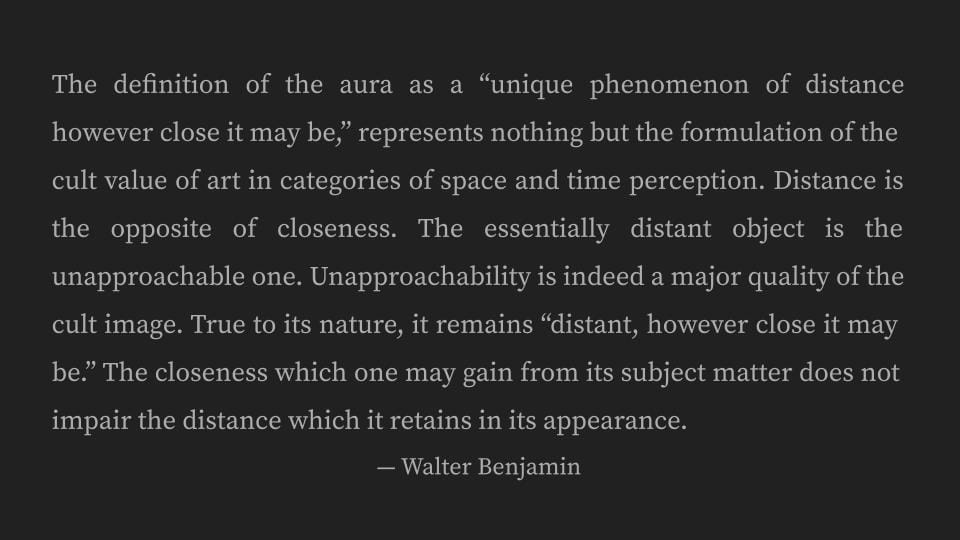
Benjamin gives his definition of aura in a note: “The definition of the aura as a “unique phenomenon of distance however close it may be,” represents nothing but the formulation of the cult value of art in categories of space and time perception. Distance is the opposite of closeness. The essentially distant object is the unapproachable one. Unapproachability is indeed a major quality of the cult image. True to its nature, it remains “distant, however close it may be.” The closeness which one may gain from its subject matter does not impair the distance which it retains in its appearance.”
And we should take him at his word: aura in categories of space and time perception, that is, those perceptions we select for, primarily out of habit, secondarily out of paying attention, and then, because we are forced to, getting out of the way of the oncoming train, should we believe it to be about to squish us.
Relief comes not in the form, phewf, only an image, but in the pleasure of recognition, where it can be taken up by habit. Again. Let’s do it again!
And let’s not get out of the way this time! Yes, the formation of the Action genre. And we can hear the echo here of Benjamin’s phrase, formulation of the cult value ... in categories of space and time perception. And we will get to this notion of cult, but right now our point is the aura
that was lost is repeated in the moving image because the incidental random and chance of them points not to the truth of the things depicted but to the truth of the time in which they are.
And is repeatable in experience: it is regained in the experience given in and by sensation from the categories of space and time perception.
We can think of aura quite literally. As a giving off, a miasma, that shifts but is freed from its objective support, like an image, a painting is from the canvas on which it’s painted. And like an image is from the screen that it is playing on. And it’s close. Held on our handheld device,
phone or tablet. And it’s distance. It’s distance is televisual. It itself, the aura, is like smoke, but with the certainty of its origination in it.
The inbetween-ness of the image, between the perceptual and the technical apparatus, relates to closeness and distance and also to being between two sorts of time, one organised and one not, to chaos and form. And we might here invoke modes of form.
The literal aura is like a vapour, a gas rising, forming the representative schemas belonging to the categories of space and time perception, but not altogether conforming to them. Because when we reach out to the moving image, there is nothing.
When the audience is said in the origin myth of cinema to have dodged the train, what did they dodge? Nothing. The train’s hurtling, oncoming approach, was not one. And were the audience to rush towards the screen showing the image, it would find the image to be equally unapproaching, distant, and unapproachable.
Close and essentially distant. Unapproachable. “Distant however close it may be.” Note also Benjamin says, the closeness which one may gain from its subject matter does not impair that distance, meaning, however perfect the image is, however real or realistic or truthful, the distance is there. It is inside the image.
The aura is this point of origination in the showing, in the thought, that is the moving image, which points to the truth of the time in which the things depicted are.
It is not incidental by chance. It is essentially incidental, in effects of the light, whether projector bulb or pixels, while the light itself has none of these qualities.
There is another myth about origins. This time in Japan.
The audience did not look at the screen. It didn’t know that was what you looked at. The audience looked up, at the play of light above their heads, at the shafts of light coming from the projector, altogether ignoring the screen.
There would have been dust dancing in the air, in the play of light and shadow. But would these have belonged to the moving image? No. They were unrepeatable.
Unlike the wave.
So we can say of the aura that it is the moving image, but what does this gain us?
A sense of this time. Yes, time again, that belonging to the first moving images was what audiences paid to see. And would pay again to see.
They got to see the origination of cinematic time. Which for us is so commonplace. We call it screentime.
And parents debate when their children should be exposed to it. As if were dangerous. And experts are called in to attest to the risks of early exposure or too much screentime. And these are the physiological effects of what is likened to an addiction to the screen, and its time: the bent neck, looking at the phone. And the psychological effects... which are usually assigned to the effects of the image supplanting reality. Not to its reality itself.
Then isn’t that what the wave film watchers wanted?
The effects of reality. In the realtime of their experience. With the chaos as a key effect. A mode or modality of the image which lets us know, yes, it’s thrillingly real.
And events in a story if you think about it: what is the story set up to do?
It’s set up for the encounter with what, for the characters, happens by chance. In other words, what is chaotic reality for them, in their inward experience of time, is for us part of the story. And this, as we said in the last lecture, is how modes and characters are related: as points of access ... to what we are now calling cinematic time or screen time. What we might call its formal title.
The organisation of stories into genres has to do with the thrillingly real prospect of seeing things happen to characters that they didn’t see coming, so that they are the modes in this case.
The notion of aura let’s us see how radically different this experience is from all of the experience, all of human experience, that had come before. There is a before and after here of an origin which is not that of the Action genre but is true to the experience of cinematic time and screentime.
Does the image then supplant the reality? Well, does the chaos in a wave film...
...supplant the actual wave?
No. It does something much stranger. We see the wave, this individual wave, and no other, as it was, as it chaotically rose and crested, like no other wave before or since, and crashed, there and then. ...but note I have to supply the context to make it seem unusual, we are so used to it by now.
The more unusual aspect of this event, the first screening, leaves moving, clouds, dust or smoke...
...is that of it happening before your very eyes, for those first audiences.
They really didn’t need characters. These films gave them unmediated access to a sort of time they might have only ever experienced before in their minds. In their imaginations. Reading a book, for example.
Reading a book, who imagines what the leaves are doing? Or the clouds above? Or really sees, or even desires to see, the exact way all those molecules arrange themselves, of the dust particles, in their Brownian motion? And if they do, is the way they move unique to these dust particles and no others?
...but we can see the effects on literature of the experience of cinematic time, in leading writers to portray the chaos of life, particularly inner life, their own and that of their characters. Realism, we might say. And yes, there is some consistency between the rise of literary realism and that of cinema, but this is more an expansion and extension of literary tropes effected by the moving image. It led some commentators on culture to the view that literature would be supplanted by cinema: that the great writers of the past would turn to film-writing. The same logic we have just seen of the image on the screen, the image of a lover or an event, supplanting and taking the place of the real thing. Where we should ask, when?
Literary Realism arose with factors of both urbanisation and industrialisation, as an entertainment for those who could afford it. Leaving out the great unwashed. Quite literally. Those whose jobs and state of life meant they were dirty.
Cinema developed through commercialisation, chiefly in America, to encompass this audience, for strictly commercial reasons: it was so expensive it needed them paying at the door.
...but I am getting ahead of the story.
...
The aura idea, “distant, however close it may be,” and at a distance not impaired by the familiarity and closeness of the subject matter, lets us into the mind of the audience who went to the cinema in the late 1800s.
It lets us get at what was thrillingly real about it. And new. That first time. When you laid eyes on documentary footage, footage documenting a familiar subject matter and one close to you, and paid attention to the leaves, waves and smoke.
...so that the makers of these clips thought to isolate these subjects... and repeat them, often in the same programme, in the same viewing, so that you could see again and once again... that one billow of smoke, like no other in all of eternity. In other words, they thought to isolate these modes. Not moments, but momentous none the less.
...
Again, a little ahead. Because what had to happen was there had to be sufficient interest for the next innovation which this isolation of subject matter was: there had to be proof that enough people would want to see waves to make the wave films.
Where was the proof?
It was again at the initiative of Auguste and Louis Lumière. Films and projectionists were, in the words of Mark Cousins, in his history of film...
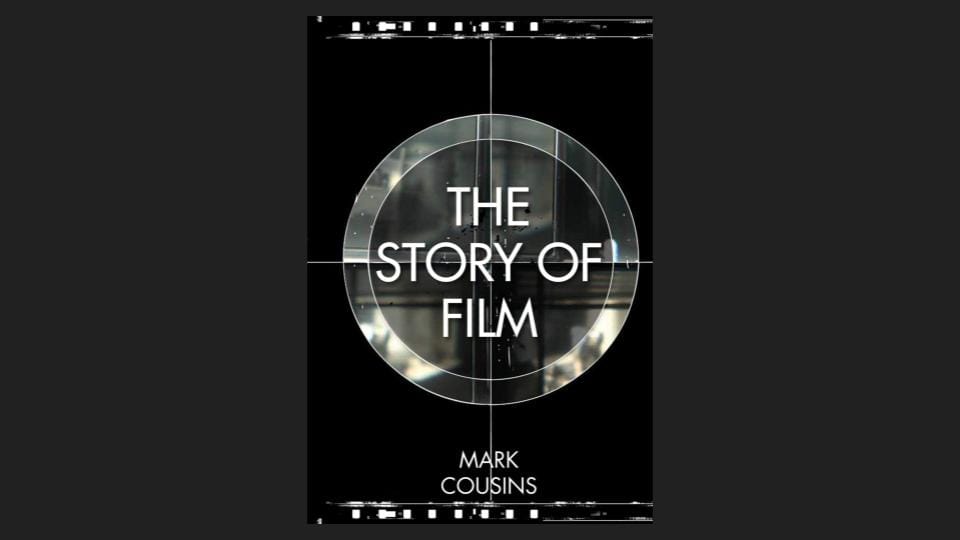
... dispatched “to every continent with such speed that within one or two years audiences in most countries had seen the famous train in La Ciotat.” The most important film for him, since he buys the myth of origin, that it wasn’t the thrillingly real chaos of incidental effects that first grabbed audiences, but the frightening impression, too soon habituated to, of the train hurtling down the tracks towards audiences... a sense of fright, I would say, that after one or two screenings, would have been hard to summon up, but, yes a thrill... A thrill the chief thrill of which would have been in participating in it as a group, in a social setting, having one’s own impressions reinforced by those around one, and going with the group. Making the OOOOoooooo noise just because one felt that’s what the occasion demanded.
And note that the Lumières’ distribution of films and projectionists took place within one or two years of 1895, so that audiences, and here’s the list, saw the films...
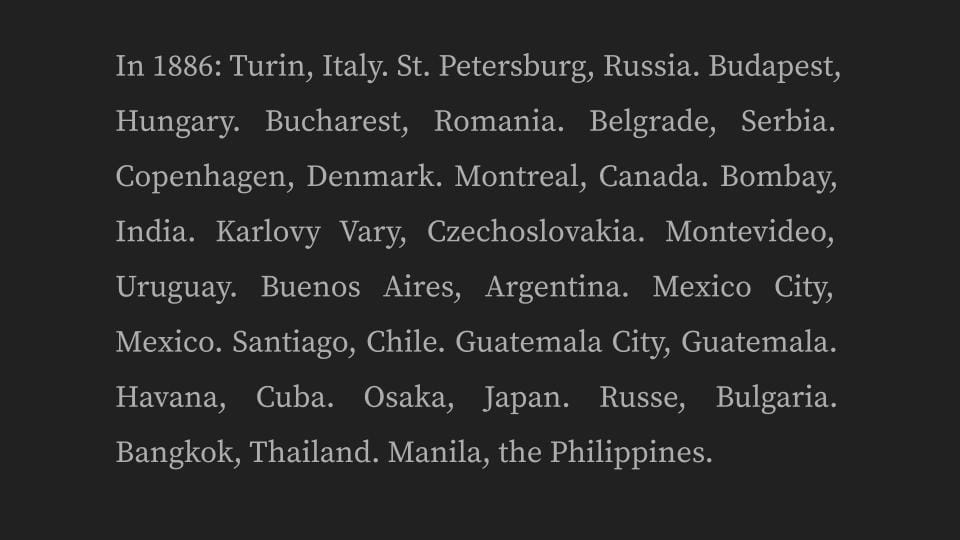
In 1896, alone: Turin, Italy. St. Petersburg, Russia. Budapest, Hungary. Bucharest, Romania. Belgrade, Serbia. Copenhagen, Denmark. Montreal, Canada. Bombay, India. Karlovy Vary, Czechoslovakia. Montevideo, Uruguay. Buenos Aires, Argentina. Mexico City, Mexico. Santiago, Chile. Guatemala City, Guatemala. Havana, Cuba. Osaka, Japan. Russe, Bulgaria. Bangkok, Thailand. Manila, the Philippines.
That’s the first year. This is global distribution. Before air travel. A distribution facilitated by the industrialisation of the means of film production: the Lumière brothers became the Lumière factory.
Employees were responsible for travelling with and showing the films. Like the seventeen year-old who took the cinematograph to St. Petersburg, Russia. He was told “to let neither kings nor beautiful women examine its mechanism.” (Cousins, 2004, 24)
We have a giant trade secret here. Worldwide participation. That almost amounts to a campaign of a Cinematic World War. One conducted with military-level organisation and coordination.
By 1900 it has reached Senegal in Western Africa and the empire of Persia, modern Iran... which interestingly did not participate in the actual Great War that was to follow a decade and a half later.
Meanwhile, in the UK, writes Cousins, Robert William Paul’s business strategy was building and selling cameras, giving British film-makers the ability to experiment for themselves. Like George Albert Smith, who, in 1898, shot the first “phantom ride.”
Combining the technologies of film and railway, giving a locomotive POV. Smith also experimented with editing and double-exposure, to produce ghostly superimposition. And cutting in a carriage interior shot with a couple about to kiss with the phantom ride POV going through a tunnel. The cutaway.
...
While in America, Cousins again, in 1897, we have the event in widescreen: The Corbett Fitzsimmons Fight...
Shot by Enoch J. Rector and shown at Tally’s Phonograph Parlor. (Cousins, 27)
Remarkable on account of the subject matter and the screening room, since it had a street frontage, with a hoarding, reading, See the Great Corbett Fight. It was not in the most salubrious area of LA, and sat between a hatmaker and a hosiery. It was not the mirrored palace of the Shah of Persia. And this is more remarkable than the format, 63 millimetres, not the standard, yes, by then, within two years, standard, 35mm. Why?
Because it was not for the hoi-polloi, the moneyed up and the gentry, but for what we might call the commercial classes. It was a consumer product, an entertainment. And then the subject matter: the subject matter reinforces the common appeal; to such an extent some contemporary commentators called it a breach in decorum, to show a boxing match, not a bourgeois feeding-time at all. This was not high art. It was hardly even art. Or, we can say, the art was in the technical achievement: to see “an event of one month prior reproduced before the eyes of a multitude in pictures that moved like life” wrote the Brooklyn Eye newspaper. (at Cousins, 28)
An event for multitudes: for the masses: such that critics and philosophers, like Theodor Adorno and Walter Benjamin of the Frankfurt School saw in it a threat to tradition, Adorno considering it, and jazz, a potential cultural disaster: the ceding of culture to the dictates of commerce.
Industrialisation of the means to production. A new urban class of consumers. Who were also at the time beginning to buy motorcars. And also, on the side of the film-makers, a way to meet the overheads of film production, through global distribution, the demands of which concentrated the factory-like conditions of early production in what would become the studio, entailing a systematisation, in the studio system, and Hollywood. And with that systematisation a specialisation inseparable from genre. So that different studios produced different genres, reusing sets, reusing actors, reusing plot-points, and streamlining operations, achieving efficiencies that would be reflected in the box-office take, and the eventual enormous wealth of the film moguls, as they became known. The heads of studios...
...but we must not think this process endemic to the US. Wherever films circulated they captured national interests in ways reflecting national obsessions, not out of respect for cultural difference, but from the point of view of desires, like those of Eisenstein in post revolutionary Russia, or in Japan Ozu.
Or in Australia, where the first feature-length film was shot, the name of which is a give-away for the national interests it engaged, The Story of the Kelly Gang.
That is, with mass appeal, the potential for mass instruction, and propaganda, was clearly seen. It’s just that in the US, making money is the national interest, commerce and capitalism the dominant ideology.
Of course, entertainment is always needed to keep the wheels greased.
The fact is, issues of gender and race also followed along the lines of these national interests and what we might call national ideological differences.
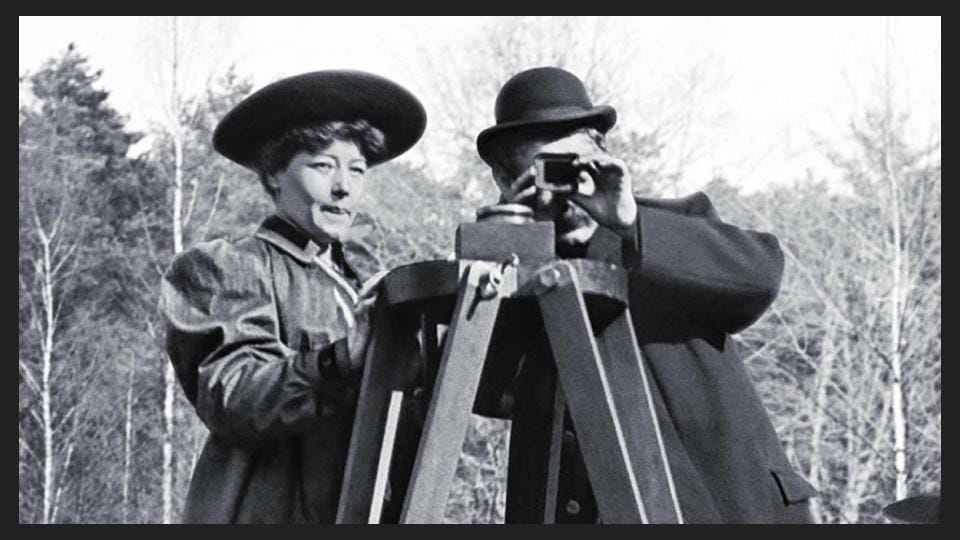
Alice Guy-Blaché directed the first ever scripted film in France in 1896, and, emigrating to the US in 1907, opened one of the earliest movie studios, under her directorship, Solax, in New York. She directed around 700 short films, including Westerns and thrillers... and, meeting the puritan demands of US audiences, biblical epics. (Cousins, 26)
The point here is that prejudices aren’t innate. They change with the times. It was easier at the start for a woman to direct a studio than later, and perhaps for different reasons. As far as race and racial segregation is concerned, the debate, as we see with Black Panther, 2018...
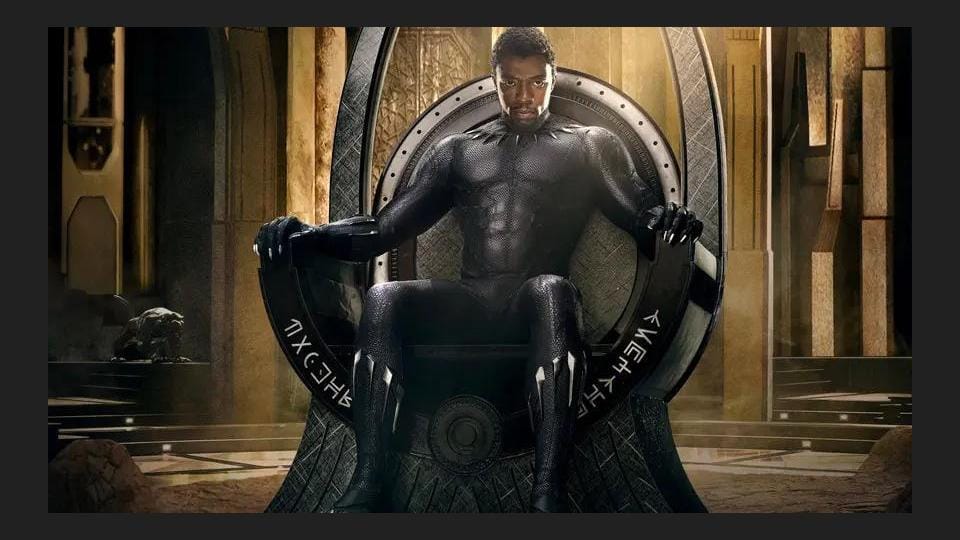
…is ongoing. And there is some sense that counter-histories, even where they gives evidence of earlier freedoms, to the official line are suppressed: part of virtue signalling is to see ourselves as the enlightened ones, the liberalisers and liberators, where that is the official line. And the drivers of inequalities are too often submerged in the noise of the signalling.
...
A thrill, the chief thrill of which would have been in participating in it as a group, in a social setting, we have said, having one’s own impressions reinforced by those around one, going with the group. As much as money, that’s a driver. And from it we gain further insight into the connection Benjamin makes between cult value and the work of art.
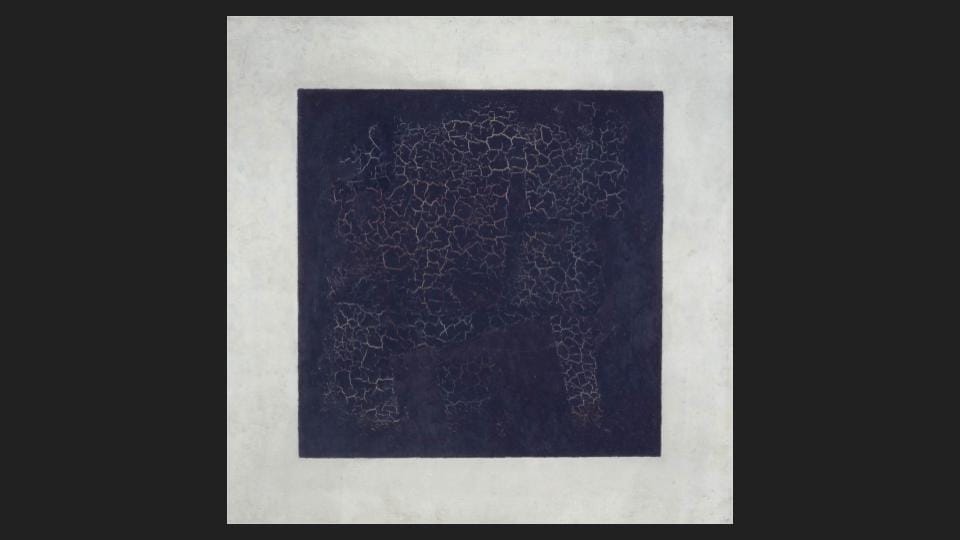
“The Work of Art in the Age of Mechanical Reproduction” has it that aura is lost when the cult value of art disappears, that is, art’s value as it is inherited from religious and other spiritual or cult-like uses. In such uses, art is like a secret guarded by tradition; like the Lumières telling their employee to let no one see the inner workings of their cinematograph: Benjamin’s view is that where the work of art is transportable and reproducible the distance which is essential to the aura of art, and of any thing, he says, is lost.
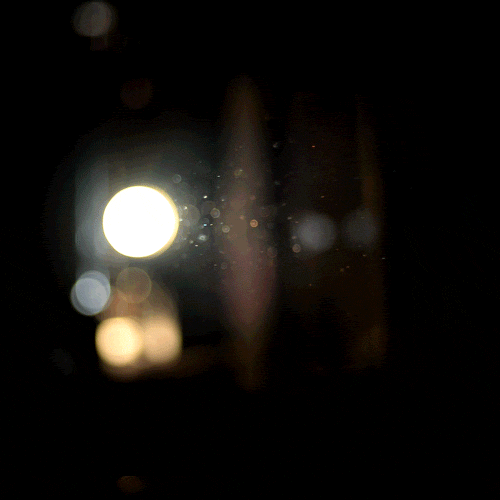
Is this snobbery, when considering art that is for the masses, where distribution and reproducibility is required? This is an argument that is ongoing. But Benjamin leaves the door open, where he says, the work of art and any thing, to the idea of aura having less to do with spatial distance or closeness, with spatial unapproachability, and with space, than with time. And this is what I think we see in the moving image, the movement-image: cinematic time. Screentime. Where it is wrong to say that the aura of the movement-image originates at the time of showing, because time originates from the showing.
What signs off on the authenticity of the image? on its value? its aura?
Chaos. The random event itself. The technical fact of capture is secondary. It is the movement of chance itself, as we experience it, which is primary.
The movement of chance itself is primary in all of its singularity. Not any wave whatsoever. This one. It is a mode. We experience in it a way of experiencing. In other words, modulation. Does this happen according to the time we experience it? I mean, the lecture starts at 9am, runs its course, and stops.
No. Because this time is internal to the moving image. It is cinematic or screen time.
Isolated, as we saw, it becomes a genre. That is, the mode is the operator. It links us into a time that belongs to the movement of the image and is internal to it. It experiences as much as we experience it.
We are in (its) process. And some would say, captured.
So we have a further inversion: the aura of art, art is always a technical category, linked to time, becomes the aura of the moving image, of cinematic and screen time. Then, the cult which guarantored the artwork in its aura becomes what it is in the nature of genre.

The cult is no longer a high one. It’s a low and common and mass-produced one.
What could be lower than the cult of b-grade movies? But this lowness shouldn’t hide from us what is at stake in cinematic time or screentime. It does not make it any less powerful.
...
What is true of the shot is true of the moving image sequence and of the moving sound image sequence. Whether a feature film, or 45 seconds; whether animated, with animated characters, or the shot that is the individual component in a montage sequence; or is simply a cutaway.
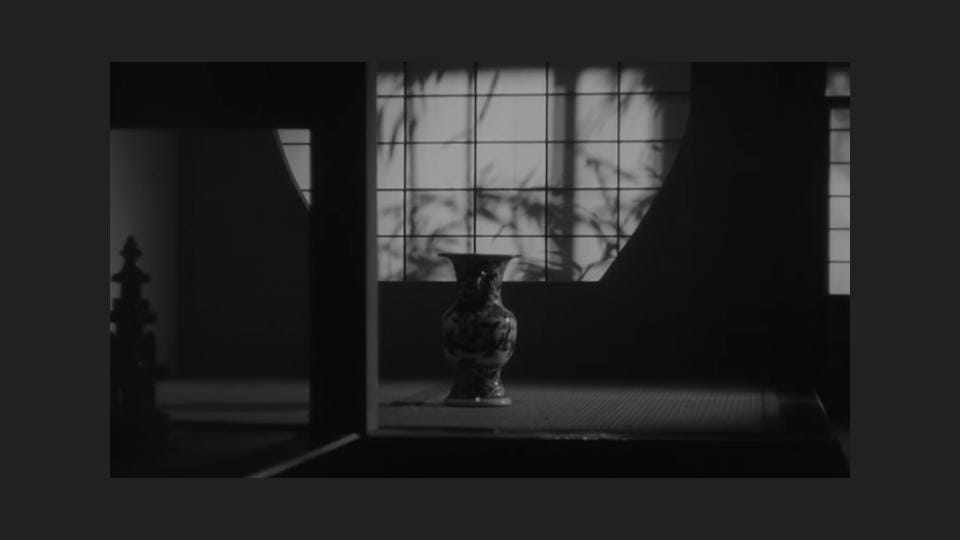
In the background of Ozu’s cutaway to the vase, the shadows of bamboo are moving on paper screens.
What is happening in the shot is what is being shown to happen.
What could not be shown before 1895 is time. Realtime. The time of duration, which is inside the shot. And inside the shot exists as a mode, modulating the shot. The shot, whether in CGI or changed through various techniques, digital or analogue effects, is the most basic element of moving images in every form.
A mode is individual, singular to the time shown in the shot, and which originates in the shot: there need not be any model for the representation: this particular mode of time is not shown by the shot. It originates in the shot, and, by modulating, involves change. Change from moment to moment. Except that the shot doesn’t change: it is not the representation of time passing, it is the time passing itself.
...but cinematic time or screentime is not a new form of time.
...
At the beginning of this course, I gave you Bergson to read. And for this week’s lecture, I gave you Benjamin. From B to B and back again.
What Bergson lets us see, helped along by Deleuze, is how the movement-image, the moving image sequence, which can be simply one shot and is never less than one shot, its minimal condition, opens a gap of hesitation that already exists in the sensory-motor apparatus of our nervous, spinal and cerebral systems: in us it is that which our nervous, spinal and cerebral systems, for being so elaborately evolved, gives us by nature, what some might call the evolutionary advantage of a kind of detour that perception takes. There is no direct line between I sense this I do that. We can even train ourselves to face oncoming trains, without flinching. There is a gap while the detour goes through images. These are acquired by habit, some might equally say instinct, and are also learnt, so give on to memories of what has been learnt from similar and learnt-of experiences. But experience can exceed these images and force us break both with habit and with what we have learnt.
The point is the hesitation preparing the body, and the brain and nervous system, for action... Thinking here is just such an action as any moving image. This is why I talked about moving images thinking.
There is a major obstacle reading Bergson: we habitually think of images as being images like we see on the screen. And on the screen, we tend to think of them, in fact we take for granted that they are, freed from time. So they are insubstantial things. Not really things at all. And this is where Benjamin comes in: we are in the habit of treating images as being their auras and nothing more. Then Benjamin comes along and says, no. Through the technical category of this art we call making moving image sequences, the fact of reproduction removes from images their auras. Which they had for playing some ritual part in a cult.
Benjamin lets us see what we have taken for granted. And this is an important point: Bergson is not writing on cinema or film, that’s not his problem; Benjamin is.
Benjamin’s problem is exactly what we face that we are not usually conscious of but that the audiences of the early 1890s were stunningly aware of and found thrilling: the aura of the event that is not reproduced in cinematic time, that is, not represented, but is reproduced by cinematic time, time itself, that originates in the moving image. Which is Bergson’s time. The time of inner experience.
It can only originate, time, in the moving image by technical, and in the late 19th century, mechanical means.
Cinematic time differs from our inner experience of time in the fact that each of our inner experiences of time is unique to each of us: so what is reproduced is not the experience, or what Benjamin calls the subject matter, in the shot. What is reproduced by technical or mechanical means by the art of making movement-images is time: the reproduction is of that time, each time the moving image sequence is shown, not for each one who has that inner experience. There it will always differ. But there is something unique that originates in the showing which is of the same time, like the time of a wave coming onto shore, a smoke billow, that can be replayed and repeated.
It is in the shot. It’s not a particular movement. It’s the particular time that movement has. At any other time it would be a different movement.
Then, along with aura and reproduction or reproducibility there’s this other insight Benjamin has, that seems hard to accommodate to our ideas here: cult. This is where, in their ritual role, images acquire their aura. And either keep it and remain unapproachable, however close they may be, or lose their aura.
We take for granted that when we think of images we are only thinking of their auras. This fact alone, that we are not thinking of the material conditions of images, the technical ones, or of their material contingency, their dependence on screens and so on, but only of images in their immaterial condition, evenescing, ungraspable, stupid to try, and unapproachable, points to something cult-like happening. And I would say it is directly linked to the social aspect.
Sitting in a darkened room watching flickering images: what could be more cult-like? ... However we know of a more cult-like power: that our connection to the moving-image is immediate and personal.
That our connection to the moving-image is immediate and personal and that we take it for granted: above all that we take its auratic quality for granted, of being unapproachable, of being no more no less than an image, and enables it to take up all of the gap of hesitation.
In other words, cinematic time by way of the cult of the image, that gives it its aura, and that is the image in its social aspect, its political aspect, as Benjamin says, and its historical aspect, replaces the time of inner experience.
Now, this is not our colonisation by images, like mind-control, but our occupation by a sense of time that belongs to the screen, that is screentime.
What happens in this time? Very little. We simply experience the time belonging to the age of mechanical reproduction. And this inaction resembles a dream.
What happens in this dream concerns us, particularly when, like in a dream, it contains personalised content; and, like in a dream, we respond to the sensations that are engaged: but it is like a wind blowing over us, stirring us either more or less deeply, and this wind, as Benjamin will say in another work, is called progress.
What is progress towards? As we said in the start, the perfection of the image; all we have left to do is perfect the images...
Should we do something else?
